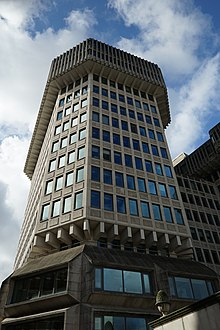Government Legal Department
The Government Legal Department (previously called the Treasury Solicitor's Department) is the largest in-house legal organisation in the United Kingdom's Government Legal Profession.
 | |
 | |
| Non-ministerial government department overview | |
|---|---|
| Formed | 1876 |
| Jurisdiction | United Kingdom |
| Headquarters | 102 Petty France, London, SW1H 9GL |
| Employees | 2,000+ |
| Annual budget | £114.7 million (2009-2010) [1] |
| Ministers responsible | |
| Non-ministerial government department executive |
|
| Website | gov |
| Treasury Solicitor Act 1876 | |
|---|---|
| Act of Parliament | |
 | |
| Long title | An Act to incorporate the Solicitor for the affairs of Her Majesty's Treasury, and make further provision respecting the grant of administration of the Estates of deceased persons for the use of Her Majesty. |
| Citation | 39 & 40 Vict. c. 18 |
| Dates | |
| Royal assent | 27 June 1876 |
| Text of statute as originally enacted | |
The department is headed by the Treasury Solicitor (formally, 'The Solicitor for the affairs of His Majesty's Treasury'). This office goes back several centuries. The office was enshrined in law by the Treasury Solicitor Act 1876 (39 & 40 Vict. c. 18), which established the Treasury Solicitor as a corporation sole (an office with perpetual succession).[3] Employees of the department exercise legal powers which are vested in the corporation sole.
The department is a non-ministerial government department and executive agency.[4] The Treasury Solicitor reports to the Attorney General for England and Wales. The department employs more than 1,900 solicitors and barristers to provide advice and legal representation on a huge range of issues to many government departments.
History
The department was historically known as the Treasury Solicitor's Department, but changed name to the Government Legal Department on 1 April 2015. The new name reflects a "significant period of change", which saw the department double in size to 2,000 staff.[5]
The head of the department combines the ancient office of King's Proctor with that of Treasury Solicitor. She has the formal title of His Majesty's Procurator General and Treasury Solicitor. The office is currently held by Susanna McGibbon[6] who succeeded Sir Jonathan Jones after his resignation on 8 September 2020.[7] She is also the Chief Executive of the department as an executive agency.
Functions
Government Legal Department lawyers work in both advisory and litigation roles. In litigation, lawyers bring and defend legal proceedings involving central government and related bodies. In advisory teams, lawyers provide advice to ministers and civil servants on both the current law and on proposed Government policies and future legislation.
The department is the authorised address for service of proceedings on most government departments, by virtue of the list published under the Crown Proceedings Act 1947.
In England (with the exception of Lancashire, Manchester and Cornwall, where the function is delegated to Farrer & Co), the Treasury Solicitor is the Crown's nominee for the collection and disposition of ownerless property (bona vacantia).[8] This typically comprises the assets of dissolved companies and the estates of persons who die intestate and with no known kin.
List of HM Procurators-General and Treasury Solicitors
King's Proctor/Procurators General
The office of King's (or Queen's) Proctor is ancient; it also came to be known as HM Procurator General.[9] The following were King's or Queen's Proctor after 1660:[10]
- 1660–1669: Alexander Cheeke
- 1669–1700: Samuel Franklyn
- 1700–1710: Thomas Smith
- 1710–1714: George Smith
- 1714–1727: Henry Farrant
- 1727–1750: Edward Greenly
- 1750–1766: Thomas Tindal
- 1766–1783: Philip Champion de Crespigny
- 1783–1804: James Heseltine[11][9]
- 1804–1815: Charles Bishop[12][13]
- 1815–1844: Iltid Nicholl[13][14]
- 1845–1876: Francis Hart Dyke[14][15]
Treasury Solicitor
Historically, there were two solicitors in the Treasury. The first (The Solicitor for Negotiating and Looking after the Affairs of the Treasury), which existed alone until 1696, had become a sinecure by 1744, and perhaps as early as 1716; from the late 18th century the office included a salary of £200 a year. It was abolished in 1800. A second Treasury Solicitor, the precursor of the modern office, was established in 1696 and was assigned all the legal business undertaken in Westminster Hall; as the first Solicitor became a sinecure, the second Solicitor became the only one responsible for legal business. By 1786, its office-holder was carrying out legal work for other secretaries of state and the Attorney-General, and in the early nineteenth century was employed by other government departments as well. From 1794, the Solicitor was also barred from running their own private practice. The salary began at £500, increased to £1,000 in 1755 and then to £2,000 in 1794; until the 1830s, the Solicitor also charged fees for work done in departments outside the Treasury, but these were then abolished and he received an allowance of £850 in addition to his salary. The whole salary was fixed at £2,000 in 1851, and then increased to £2,500 in 1872.[16] The following were Treasury Solicitors after 1660.[16]
Treasury Solicitor (I; a sinecure by 1744 and abolished in 1800)
- By 1661: John Rushworth
- By 1673: Sir William Turner
- 1676–1679: John Ramsey
- 1679–1685: Thomas Lloyd
- 1685–1689: Philip Burton
- 1689–1696: Aaron Smith
- 1696–1716: Henry Baker[17]
- 1716–1728: Philip Horneck
- 1728–1729: Edward Roome
- 1729–1737: Charles Valence Jones
- 1737–1744: Charlton Hayward
- 1744–1800: Hugh Valence Jones
Treasury Solicitor (II; from 1696)
- 1696–1700: Nicholas Baker
- 1700–1715: William Borrett
- 1715–1730: Anthony Cracherode
- 1730–1742: Nicholas Paxton
- 1742–1756: John Sharpe
- 1756–1765: Philip Carteret Webb
- 1765–1775: Thomas Nuthall
- 1775–1794: William Chamberlayne
- 1794–1806: Joseph White
- 1806–1818: Henry Charles Litchfield
- 1818–1851: George Maule
- 1851–1866: Henry Revell Reynolds
- 1866–1871: John Greenwood[18]
- 1871–1875: John Gray[19][20]
- 1875–1894: Augustus Keppel Stephenson[21]
Procurators General and Treasury Solicitor
In 1876, Augustus Keppel Stephenson, the Treasury Solicitor, was appointed Queen's Proctor and Procurator General; since then, the offices of Procurator General and Treasury Solicitor have been held together.[21] By 1971, the office came with a salary of £14,000 a year.[22] The following have been jointly HM Procurator General and Treasury Solicitor:[23]
- 1876–1894: Sir Augustus Keppel Stephenson, KCB[15][24]
- 1894–1909: Hamilton Cuffe, 5th Earl of Desart, KP, KCB, PC
- 1909–1923: Sir John Paget Mellor, 1st Baronet, KCB
- 1923–1926: Hon. Alfred Clive Lawrence, CBE
- 1926–1933: Sir Maurice Linford Gwyer, GCB, KCB, KCSI, QC
- 1934–1953: Sir Thomas James Barnes, GCB, Kt, CBE
- 1953–1964: Sir Harold Simcox Kent, GCB, QC
- 1964–1971: Sir William Arthur Harvey Druitt, KCB
- 1971–1975: Sir Henry Gabriel Ware, KCB
- 1975–1980: Sir Basil Brodribb Hall, KCB, MC, TD
- 1980–1984: Sir Michael James Kerry, KCB, QC
- 1984–1988: Sir John Bilsland Bailey, KCB
- 1988–1992: Sir James Nursaw, KCB, QC
- 1992–1995: Sir Gerald Albery Hosker, KCB, QC
- 1995–1996: Michael Lawrence Saunders, CB
- 1997–2000: Sir Anthony Hilgrove Hammond, KCB QC (Hon)
- 2000–2006: Dame Juliet Louise Wheldon, DCB QC
- 2006–2014: Sir Paul Christopher Jenkins, KCB, QC (Hon)
- 2014–2020: Sir Jonathan Guy Jones, KCB, QC (Hon)
- 2021–present: Susanna McGibbon
See also
References
External links
 Media related to Government Legal Department at Wikimedia Commons
Media related to Government Legal Department at Wikimedia Commons- Government Legal Department
- Bona Vacantia
